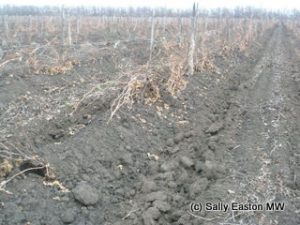Next stop – krasnostop

Buried krasnostop vines
Krasnostop was the most interesting indigenous black grape variety I came across during my recent visit to Russia.
There are two clones, and there is certainly a notably regional rivalry regarding the quality and style of those said clones. Krasnostop zolotovsky is found in the Rostov region, while krasnostop anapsky is found around Anapa on the Black Sea coast in the Krasnodar region.
The variety has lots of colour, tannin, acidity, flavour, thus far giving it much in common with a few top quality varieties from further west – cabernet sauvignon and syrah, for example. In my limited tasting, below, wines come out generally as medium-bodied with the potential for real elegance, both of which score highly for me.
Importantly, the variety winter-hardy, which is pretty much a basic requirement for growing vines in Russia. In Rostov winters get town -25 to -28°C. It’s also well adapted to a short-ish continental growing season, generally being harvested around 10 days before late-ripening cabernet sauvignon. Ruben Sáenz, of Spain’s Bodegas San Prudencio, and consultant for Tsimliansky Wines said krasnostop “has a big spine of flavours with all-round harmony, fruit, structure, acid and tannin.” Fellow Rostov producer Maksim Troychuk, of Vedernikov said “krasnostop zolotovsky is our pride. It’s one of the best grapes in the world. It is a strong grape variety, high in alcohol, acid, tannin, high everything. It’s unique and surprising and interesting.” No argument from me on that.
We were told a couple of stories about translation, one saying it translates as ‘red foot’, another than ‘stop’ means either foot or a drinking shot. Troychuk said “the colour of the stalk is red, and the shape is like a shot glass.”
Whatever it means, it makes a tasty wine.
Tasting, in situ, November 2012
Kuban-Vino, Château Tamagne Krasnostop 2011, Krasnodar
Bright, red cherry, cranberry and lingonberry fruits. Bright and crunchy in medium body; fresh with some good density. Supple, light tannins and with youthful grape structure. Freshly balanced with decent length. Good.
Château le Grand Vostock, Le Chene Royal 2010, Krasnodar
65% krasnostop, 35% cabernet franc. About 16-18 months in French oak, 20% new.
Smoky graphite and red fruits on nose. Smooth palate attack, very smooth texture all through the palate, medium weighted with plenty of intensity. Dark red fruits, bit of dark chocolate in the middle. Young texture and profile, needs time to settle in, attractive fresh balance, with silky redcurrant and raspberry fruits on the smooth, elegant core. Vg.
Vinodelnya Vedernikov, Krasnostop 2010, Rostov on Don
No oak, all stainless steel. Bright mulled-spice cherry notes. Smooth attack, sweetly-spiced, with rich mulberry and dark-chocolate, even with dark-choc/bitter orange skin combo. Sweet forest-berry fruited, youthful as anything, succulent with fresh/firm core. Supple, plentiful tannins are proportioned and toned. Big and lovely. Delicious. Certainly don’t taste 14.5%, seamlessly integrated. Vg.
Vinodelnya Vedernikov, Krasnostop 2010, Rostov on Don
Fermentation in stainless steel. 50% in to new oak for one year. 50% from stainless steel. Toasty spices are the first nose, fruit is muted. Toasted spices and a grip on the side palate, which for me detracts, as well as mutes the exuberance of the fruit. Good wine, but less exciting than the previous wine.
Vinodelnya Vedernikov, Krasnostop 2011, Rostov on Don
100% new oak. Dark colour. Strong, balsamic, chewy oak, raw and dominating the big fruit flavours. Will it mellow? There is big, sweet fruit here, succulent mulberry, blue berries, black fruit, loganberries. I suspect this will be very good in five years time – it has big fruit, big freshness, big, sweet tannin – all the components for ageing.
My visit to Russia was sponsored by the Union of the Oenologists and Winemakers of Russia.



